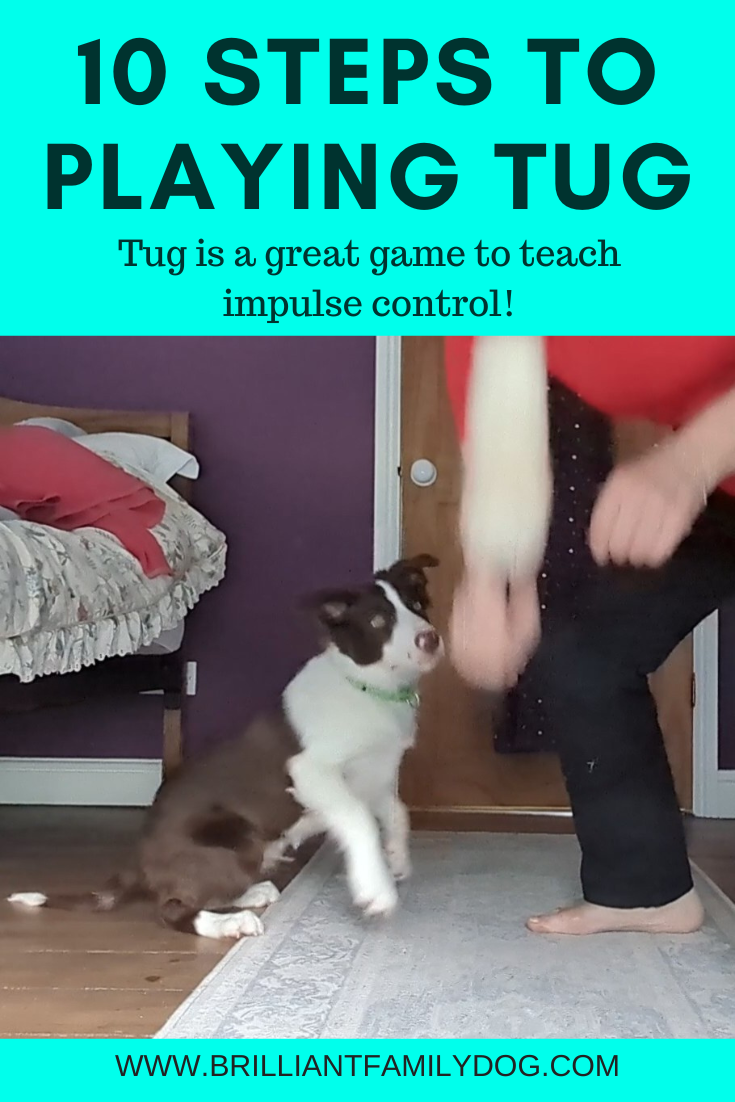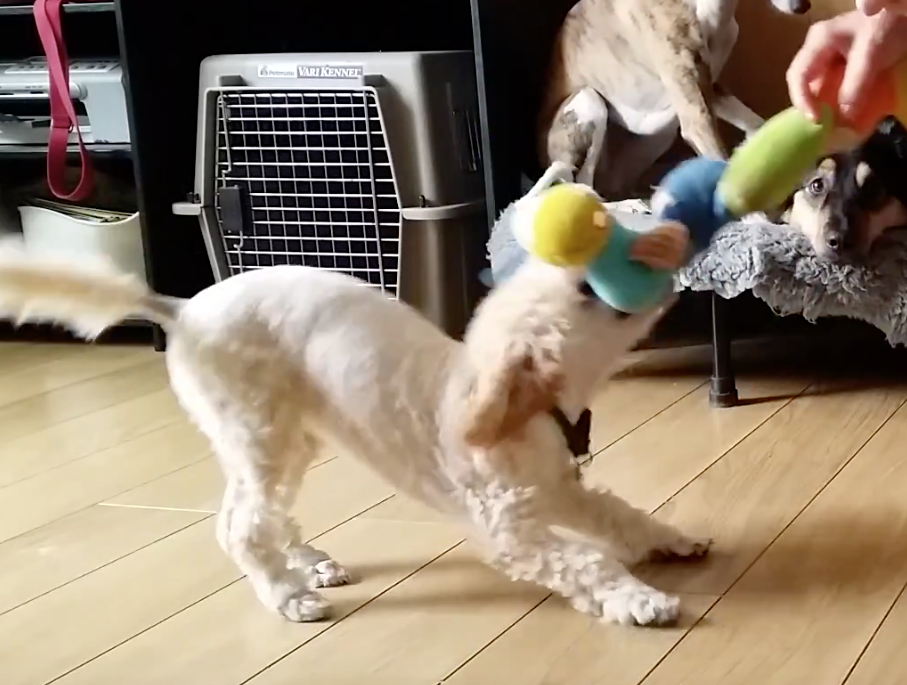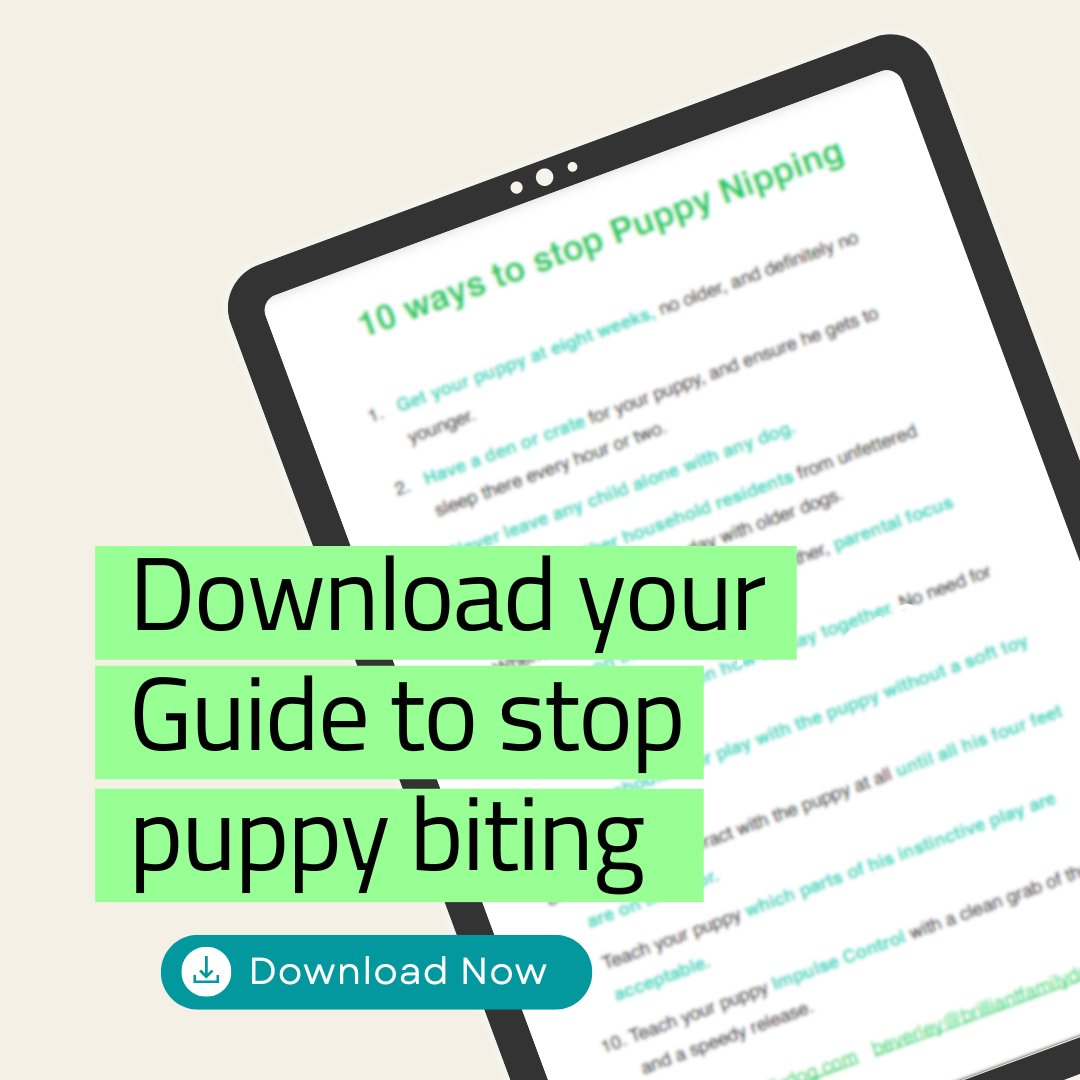Would you love to be able to play with your dog without toothmarks all over your hands and arms, rips in your clothes, and your shoe-laces being undone?
There is a WAY to teach this! Phew!
Many folk think you just waggle a toy in your dog’s face and all will be sunlight and joy as they gently tug the toy, let go as soon as you ask, and patiently wait to be offered it again.
Well - I have news for you . . . You can get all those things (without the “waggling in the face” bit, which no-one would like) by following a few basic rules. What’s more, those rules will extend to every part of your life with your dog. Dogs’ teeth should never touch human skin, and we have great ways for your dog to learn this - all without force or intimidation (or yelling).
And you can see my puppy waiting for the game to start in the picture above.
Instinctive Drives
The thing is, you are harnessing a very strong instinctive drive in your dog, and turning it to your advantage instead of trying to work against it.
All dogs, whatever the breed or type, have the same instinctive drive - to locate prey, stalk it, chase it, catch it, and kill it.
But dogs have been bred for generations to stop at different points in that sequence - Border Collies, for instance, locate, stalk, and chase sheep, but stop short of grabbing them. Gundogs may be only required to locate the prey, or to bring it back undamaged. Terriers on the other hand are required to simply clear the barn of rats, so they do the whole sequence.
It’s because it’s hardwired that this is the best game of all for your dog, and they learn it really fast!
.
In the Brilliant Family Dog Academy we go into detail on just how to teach this, with the full 10 rules - yes, 10 of them that you need to follow - carefully taught, along with personal tuition and troubleshooting for serious mouthers!
How does this teach impulse control to your dog? Well, he has to WAIT to be able to grab the toy. That is good early learning for any puppy who wants something. If he pounces as soon as he sees his prey, rather than lining it up and thinking about it, the bunny will probably hop away. Taking time to assess the situation is vital!
Then he learns to tug with you with equal strength. You don’t want your big dog pulling you over! It’s a game - that means you both enjoy it.
And of course, he learns to release instantly on request .. and not to try and grab it again! That’s when a lot of bitey damage can be done.
If you try to snatch something away from a dog, whether it’s a toy, your shoe, a baby, a kitten - you are stimulating the chase-and-grab instinct. So there’s a way to do this without provoking that reaction - and we can show you!
Not only will you be able to play enjoyable tuggie games with your dog, but you’ll also be able to ask him to give you whatever’s in his mouth if you’re worried he’s picked up something dangerous. Double whammy.
10 Steps for playing Tug
Teach your impulsive dog impulse control
Coco at 15 weeks pulls hard on the tug
Choose a toy that is soft on the mouth, long enough for you to be able to stand up while playing, keeping teeth at one end and hand at the other. It needs to be narrow enough for your dog to grab it easily. Fleece plaits are excellent, a soft toy like a monkey with long flappy legs, or sheepskin or rabbitskin tug. It’s your toy. You allow your dog to play with it when you want, and only if he keeps to the rules. Because it’s never left on the floor - and the only time your dog gets to play with the tug is with you on the end of it - it becomes a very high-value toy.
You are harnessing a very strong instinctive drive in your dog, and turning it to your advantage instead of trying to work against it. All dogs, whatever the breed or type, have the same instinctive drive - to locate prey, stalk it, chase it, pounce, catch it, and kill it. Dogs have been bred to stop at different points in that sequence - Border Collies, for instance, locate, stalk, and chase sheep, but stop short of grabbing them. Terriers on the other hand are required to simply clear the barn of rats, so they do the whole sequence. It’s because it’s hardwired that this is the best game of all for your dog.
When playing, always keep the tuggie low on the floor - this is to prevent your pup jumping and injuring himself as he lands. It also keeps the teeth pointing downwards and he’s less likely to grab your hand or sleeve. You’ll get hurt if he’s leaping up to catch the toy.
Coco starts to chase the toy
4. Start by snaking the tuggie around on the floor, like a rabbit or a rat. Remember, rabbits don’t lollop along and jump into dogs’ mouths!
5. So don’t flap the toy in his face. Wiggle and jerk it around on the floor simulating a rodent’s action - stop, twitch whiskers, run - this is what stimulates the chase instinct and is the signal to play. You never let go of the tug. It may take a while for your puppy, or a dog new to play, to chase - and he may start by pouncing and stamping on the toy. Now encourage that chase and he’ll soon be grabbing it with his mouth.
6. Encourage your dog to grip tight on the tug. Pull just enough to get him pulling back, and if he lets go: “Oh, you lost your dinner!” and start again. Have a great game, but don’t be too rough or hurt his teeth. Growling is part of the game - you can growl too.
7. When you’re ready, relax your pull so the tuggie goes limp (animal now dead) and hold a treat to your dog’s nostrils. Some dogs cannot let go if the tug is taut. As he lets go to eat the treat, put the tuggie behind your back - not past your face! The reward for letting go? Your dog gets to play again!
8. Bring the tug out from behind your back, and tease him a little with it around your waist-height. If he tries to grab it, it goes straight behind your back (never past your face). Repeat till he shows that he wants it but is not jumping or grabbing, then immediately whack it to the floor - game on! He doesn’t have to sit or stay - just show that he wants it, but he’s not going to snatch it. He’ll soon learn that he only gets the toy when it’s whacked on the ground. This is a great protection for small children carrying teddy bears about, and for your sleeves.
Coco waits for the game to start again
9. As you both become more expert at this game - which should become your dog’s top favourite - you can use the cue "Geddit" as you whack the tuggie to the ground, and "Give" as your empty hand approaches his nose. In time you can offer him the toy off the ground, so long as he knows he can never grab it. Sometimes, cover the toy with your hand and watch your dog working out how to hold it without touching you.
10. If his teeth touch your hand or sleeve, your dog will be aware, so shriek to interrupt him, put tug behind your back, and wait for a moment for calm before offering it again. He should now be much more careful. If he’s over the top, put it away till later. He may be too tired to play nicely. If a puppy can’t control his teeth, it usually means he’s overtired and needs a zizz in his crate.





